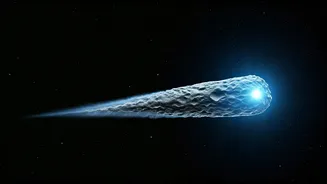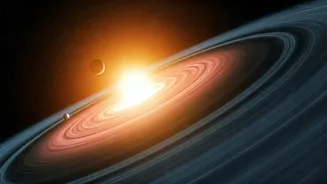An Interstellar Wanderer
Comet 3I/ATLAS, classified as an interstellar comet, is a celestial wanderer from beyond our solar system, making its journey a subject of intense scientific
scrutiny. Its very presence offers a rare opportunity to study materials and conditions from a distant region of space, offering invaluable data to researchers. The comet's trajectory, movement, and the changes it undergoes provide insights into the dynamics of the interstellar medium and the composition of celestial bodies outside our immediate cosmic neighborhood. This comet’s uniqueness lies in its origin. Unlike comets originating from within our solar system, 3I/ATLAS is a visitor from another star system, carrying with it a 'cosmic time capsule' of sorts.
Tracking Comet's Path
The movement and visibility of 3I/ATLAS became a focal point for astronomers and skywatchers across the globe. Analyzing its path through space allowed scientists to determine its trajectory, velocity, and future positions. This information is vital for forecasting when and where the comet might be visible from Earth, enabling optimal observation conditions. Its visibility also depended on factors like its distance from the sun, the amount of dust and gas it released, and the position of Earth. Tracking its behavior as it approached and moved away from the sun offered scientists crucial data about how these interstellar bodies interact with solar radiation and other elements within our solar system. The comet's journey presented both challenges and excitement for those hoping to witness it.
Image Reveals a Mystery
The release of images of 3I/ATLAS, particularly those captured by space agencies such as the Japanese space agency, sparked worldwide interest and excitement. These images offered a glimpse into the comet’s physical characteristics, its coma (the cloud around its nucleus), and its tail – or lack thereof. The quality and detail of the images provided unprecedented views of this celestial object. The images revealed unexpected features and behaviors, including the apparent disappearance of the comet's tail. These images led to speculation about the comet's composition and the possible causes for this visual change. The stunning visuals captivated both the scientific community and the public, creating a greater understanding of our universe.
Origin of 3I/ATLAS
Understanding the origin of 3I/ATLAS is pivotal for deciphering its properties and significance. As an interstellar comet, it did not originate from within our solar system. Therefore, scientists are keen to identify its parent star system, the environment it was born in, and the materials it contains. Determining its origin aids in comprehending the diversity of planetary systems throughout the galaxy. Interstellar comets are believed to originate from the Oort cloud-like regions surrounding other stars. The data collected from the comet could revolutionize our current understanding of planet formation and the building blocks of life in the universe. This provides a cosmic window into the formation processes of other star systems and offers potential insights into the origins of our own solar system.
Observation Tips for Skywatchers
For skywatchers eager to observe comets like 3I/ATLAS, specific tips and tools are necessary. Locating a comet requires knowledge of its predicted position, which astronomers usually provide in the form of ephemerides. Using a telescope or binoculars is helpful, though comets can sometimes be seen with the naked eye under dark sky conditions. It’s also important to observe from a location free of light pollution for optimal viewing. Understanding the comet’s behavior and characteristics can enhance the viewing experience. These may include knowing its magnitude, the expected brightness, and the predicted tail direction. Skywatchers can enhance their experience through these practical tips, allowing them to experience the marvels of space. The opportunity to witness these celestial bodies offers a unique connection with the cosmos.
The Missing Tail Explained
The question of why comet 3I/ATLAS's tail seemed to vanish is a fascinating one. The tail's disappearance can be attributed to several factors. Comets have two main types of tails: a dust tail and an ion tail. Dust tails are made of dust particles that reflect sunlight. Ion tails are made of ionized gas and are pushed away from the sun by solar wind. The tail's appearance can be affected by the comet's composition, its interaction with solar radiation, and the way it’s viewed from Earth. The apparent lack of a tail could be due to factors like a change in its dust production, the comet’s orientation, or the scattering of light. Understanding these dynamics offers insights into the physical processes at play and provides a deeper appreciation of the comet's behavior.












